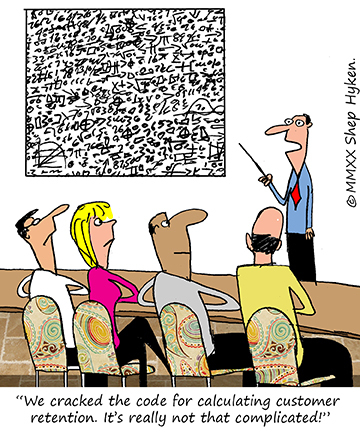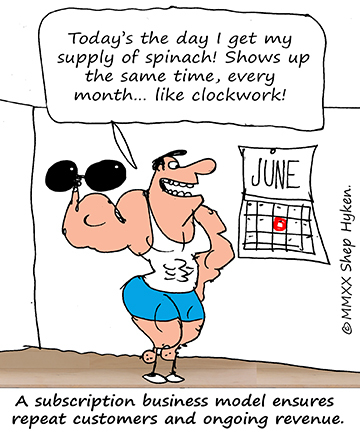Shep Hyken's Blog, page 103
July 1, 2020
You Can’t Automate Your Customer Relationship
I recently wrote an article in Forbes about how three out of four customers are more loyal to your employee than your business.
This research came from OnePoll on behalf of DaySmart Software. They surveyed 2,000 Americans and found that in many businesses, customers are more loyal to the employee—so much so that almost half (48%) will follow their favorite employee if they leave to work at a competing business.
What does that mean for you? Dr. Bobby Low, co-founder of alignXM, a company that that helps its clients understand the human experiences that impact their long-term success, commented on the article and wrote, “All the more reason to make sure you can keep the talented employees you have. If they leave and take 3 out of 4 customers with them, that could be painful to a company. Are we seeing this shift more and more back to relationship-based business? I have consulted hundreds of tech companies and I can’t even tell you how many of them say, ‘we are trying to automate the relationship with our customer.’ That makes me want to fall over.”
I don’t know if I’ll fall over, but my response was short and to the point: You can’t automate a relationship. You can only automate a process.
Many companies are automating their processes, which can make it easy for the customer. Consider how easy it is to order from Amazon, Walmart, Target or other online retailers that have a streamlined process. But it goes beyond just ordering merchandise. Some companies are automating their customer service process, which includes self-service channels.
Let me be clear on this “automation-mania,” as I like to call it. If it’s good for the customer, then it’s worth considering. Just be careful you don’t lose the personality of your company. This is where it gets tricky. The best companies have figured out the balance between a digital or automated experience and an in-person experience. Many customers want and need to have an interaction with employees. To automate the relationship with your customer puts you at risk of commoditizing your business.
Any company has the capability to create an easy automated process. In some cases, it may even be a beneficial thing to do. Just be careful about losing the connection you have with your customers. I’ve said this before, and it bears repeating: The greatest technology in the world hasn’t replaced the ultimate relationship-building tool between a customer and a business—the human touch.
Shep Hyken is a customer service expert, keynote speaker, and New York Times bestselling business author. For information, contact 314-692-2200 or www.hyken.com. For information on The Customer Focus™ customer service training programs, go to www.thecustomerfocus.com. Follow on Twitter: @Hyken
(Copyright © MMXX, Shep Hyken)
The post You Can’t Automate Your Customer Relationship appeared first on Shep Hyken.
June 30, 2020
Amazing Business Radio: David Priemer

The Customer Experience is the Product
Creating Value in the Customer Experience Through Empathetic Selling
Shep Hyken interviews David Priemer, founder and Chief Sales Scientist of Cerebral Selling. They discuss his book, Sell the Way You Buy: A Modern Approach to Sales That Actually Works (Even on You!), and how a great customer experience is the best sales strategy you can implement.








Top Takeaways:
The product or service you sell isn’t actually your product—the experience you provide your customers and clients is your product! In short, the experience is your product.
Your goal should be to create a beautiful product, and then elevate that product to another level through the amazing experience you provide.
Salespeople must consider the tactics they’re using on their customers and ask themselves if those tactics would work on themselves. If you wouldn’t respond well to a certain tactic, odds are your customer won’t either.
Customers often make purchasing decisions based on subconscious factors rather than specific, tangible metrics. Often, it comes down to the customer’s experience and how a business made them feel.
Experience beats virtually everything else. When everything else is equal, the experience is what will set your business apart.
Think about not only what contributes to a great experience, but also about what detracts from that experience. Work to eliminate those factors for your customers.
Traditional sales “closing tactics” can actually become a detractor to the overall experience. Studies have shown that customers will resist when they feel their freedom to choose is restricted.
Remember that a good experience is one without friction!
Oftentimes, the products and apps that consumers love most (because of the way they’re designed) are designed by companies with an amazing culture and amazing employees. An amazing experience is pervasive.
Quotes:
“The experience is the product, and everything is about that experience. We are all in sales and therefore we all have a role to play in terms of creating that amazing experience for our customers.”
“Nowadays, when there are a million products and services that do similar things and customers have infinite choice, they will choose based on experience more than the intrinsic properties of the product itself.”
“Sell to your customers in an empathetic way that they believe and feel. At the end of the day, experience is a discretionary feeling. Value is a feeling.”
About:
David Priemer is the founder of Cerebral Selling and the author of Sell the Way You Buy: A Modern Approach to Sales That Actually Works (Even on You!). He is the former VP of Salesforce, where he created the Sales Leadership Academy program.
Shep Hyken is a customer service and experience expert, New York Times bestselling author, award-winning keynote speaker, and your host of Amazing Business Radio.
The post Amazing Business Radio: David Priemer appeared first on Shep Hyken.
June 29, 2020
5 Top Customer Service Articles For the Week of June 29, 2020
Each week I read a number of customer service and customer experience articles from various resources. Here are my top five picks from last week. I have added my comment about each article and would like to hear what you think too.
4 Actionable Customer Experience Statistics For 2020 by Daniel Newman
(Forbes) The following are five statistics that show customer experience is more than just a trend; it’s a full-blown tide that will shape how businesses must need to operate moving forward.
My Comment: The author took four statistics – and you may be familiar with these – and suggested specific actions to take as a result. Of course, you knew that most buyers will pay more for a good service experience, but are you doing anything about it? Don’t just read these and think about them. Use them as a catalyst to take your CX to the next level.
The Definitive Guide to Monetized Net Promoter by Sarah Frazier
(CustomerGauge) In this eBook, we’ll discuss the four steps within this new model and summarize findings from our white paper that will help you capitalize on customer feedback and grow your bottom line.
My Comment: The Net Promoter Score (NPS) is one of my favorite methods for measuring customer sentiment. A high score tells you your customer is happy enough to recommend you. Great job! But there’s more. This report will help you learn how to monetize the score. Once again, don’t just read and think about these ideas. Take action on them!
Excellence in customer service in the new normal by Jeff Wolf
(SmartBrief) In my coaching and consulting sessions with executives during the pandemic, we’ve discussed critical issues such as speed, agility, resilience, pivoting, adaptability, prioritizing, change, strategy, scenario planning, transformation, rebuilding, rethinking and much more.
My Comment: I admit to being tired of the phrase, “new normal,” but I’ll get over it. No doubt we are in a different place than we were just four or five months ago. This short article covers a concept that is more important than ever, and that’s customer trust. It’s imperative we create trust and confidence with our customers. To me, that’s always been true, but it is now more important – and truer than ever.
Six strategies to build your post-COVID customer experience by Hazel Morton
(365Retail) These new habits and priorities will benefit some companies while hurting others. For both, it’s critical to look at business through the customer lens to create a blueprint for customer engagement and loyalty in the months ahead.
My Comment: As the economy around the world is opening up post-COVID-19, there are plenty of people weighing in on what’s important. Here are six strategies that will help you navigate the return of business. Pay attention to number five, which is to “Think Local.” I’ve been a big believer that the best companies are able to deliver a local flair to the experience.
Retailers Face a Data Deficit in the Wake of the Pandemic by Angel Evan and Amber Rivera
(Harvard Business Review) This recalibration exercise will help retailers quickly figure out how to stay relevant as American consumers change.
My Comment: I found this article fascinating. When the world went into a shut-down, we did more than just lose some – if not all – of the business we were doing. We also lost the data/information that went along with it. We lost the ability to spot a trend, manage distribution by the numbers and more. This is referred to as an information deficit, and here is a short list of five ideas on how to deal with it.
 Shep Hyken is a customer service expert, professional speaker and New York Times bestselling business author. For information on The Customer Focus™ customer service training programs go to www.TheCustomerFocus.com. Follow on Twitter: @Hyken
Shep Hyken is a customer service expert, professional speaker and New York Times bestselling business author. For information on The Customer Focus™ customer service training programs go to www.TheCustomerFocus.com. Follow on Twitter: @Hyken
The post 5 Top Customer Service Articles For the Week of June 29, 2020 appeared first on Shep Hyken.
June 26, 2020
Guest Post: Customer Service Automation During COVID-19. When and How to Use it Right.
This week we feature an article by Daryna Lishchynska, a Content Manager at BotsCrew. She shares research and information on how brands can transition their services to online platforms during COVID-19.
*This article was previously posted on BotsCrew’s blog.
The outbreak of COVID-19 has made a massive impact on most of the businesses – from grocery stores to luxury goods brands. Due to coronavirus quarantine and self-isolation, retailers are closing their physical stores and moving their service online. And with the more people staying at home, the demand for online ordering and delivery is currently booming.
Ordering and Delivery Increase During Coronavirus Outbreak
Many companies have been reporting that they are limited in delivery services right now, and some clients might receive their orders with a few day delays. To keep up with the huge increase in orders and deliveries, some big companies are announcing large-scale hirings. For example, Amazon plans to hire an additional 100,000 warehouse and delivery workers, along with raising the salary by 2$/hour. And Walmart announced its plans to hire 150,000 new workers through the end of May.
Instacart – grocery-delivery service reported to The San Francisco Chronicle that “This past weekend, we saw the highest customer demand in Instacart’s history in terms of groceries sold on our platform,”
And the wholesale retail giant Costco said that “We are currently experiencing a monumental surge in our sales and foot traffic in the warehouse. In response, we are opening up the seasonal hiring period to help us increase the size of our staff and ease the pressure through this busy period.”
Not only grocery retail has been experiencing a growing delivery demand. Domino’s, Papa John’s, and Pizza Hut are together hiring more than 50,000 new employees due to the coronavirus quarantine.
“We’ve been a lot busier,” said Domino’s delivery driver and pie maker Noah Reedy to WQOW. “We’re up 21% overall in sales. As a delivery driver, I’m in and out the door all the time, which is great because people are very appreciative of us and we’re very appreciative of them. It’s every little pizza boy’s dream.”
What People Are Buying During the Quarantine
New research by Nielsen has shown that people are not only stockpiling emergency supplies and groceries, but they’re also starting to think beyond emergency items. “In the U.S., sales of aerosol disinfectants, for example, were up 19%, while air cleaners and purifier sales were up nearly 3% in the week. Longer-term, we expect similar ripple sales in hand and body lotion—simply because an increased focus on hand washing and disinfecting will have a negative effect on the skin.”
Based on Nielsen Spectra demographic matching, Nielsen found that top potential cross-merchandising products include disposable diapers, baby food, and baby needs.
Meeting the Rising Demand With the Right Resources
Not only delivery and ordering processes are experiencing growing pressure, but customer service and other client-facing departments are struggling as well. Due to coronavirus online shopping spikes, more people are contacting support with the repetitive questions about ordering, delivery, and working process during COVID-19.
While retail giants like Amazon, Walmart, etc. are opening huge hirings, there is another way to meet growing online demands. Many companies have started looking at automation as a life vest for their services. Smart automation solutions like chatbots can help companies meet their clients’ needs online without having to hire extra workers, extending working hours, or raising salaries.
When Life Gives You Lemons–Make Lemonade
With the current COVID-19 outbreak, brands can use this as a possibility to automate their services that will be beneficial not only now but also bring results in the long-run. Here are the top retail chatbot use cases during COVID-19:
Ordering
“Online grocer Fresh Daily experienced 321% sales revenue increase in the seven days of CNY”
Chatbots can chat with clients to help make the purchasing decisions and give advice and answers about the product they want to buy. The chatbot can collect the required data from the customer, like their delivery address, contact, and payment information. Additionally, chatbots provide instant answers to multiple people at once. This means that brands can assist many more customers in a shorter time which leads to a big rise in the sale rates.
“$112 billion projected value of chatbot eCommerce transactions by 2023” Juniper Research
Delivering
Chatbots in delivery can answer clients’ questions about delivering during coronavirus and help customers track their orders. This allows brands to reduce the number of repetitive questions like “Are you delivering during quarantine?” or “Do you have contactless delivery?” etc. Also, because delivery services are swamped right now, it takes more time for a client to receive the order. “Carrefour saw a 600% increase in vegetable deliveries during the CNY period”. And chatbots can help clients monitor their deliveries in real-time and know exactly when they’ll get their parcel. Moreover, chatbots can help businesses save around 30% of customer support costs.
Picking up
Many companies are experiencing a shortage of delivery personnel. And some companies don’t provide delivery services at all. So, these brands can use chatbots to collect orders from customers, and when it’s ready, the bot can notify the client that he can come and pick up his order. Customers won’t have to call and wait; they just text a chatbot, see pictures of products, and make an order by themselves. This way, you’ll be able to save a fortune on delivery while keeping your business alive during COVID-19.
Learning about the product
Combining with virtual reality, companies can create digital fitting rooms, where customers can “try on” products they like. Using a phone camera, clients can put on makeup, try on clothes, or even see how cars will look like in real life without leaving their homes.
With the current COVID-19 outbreak, there is no other way for a brand to live, other than transferring all their service online. More and more customers are fully transitioning to e-commerce, so brands have to follow their clients to meet their needs digitally. However, not all companies are ready for this kind of shift. And to be able to meet the growing amount of online orders and deliveries, companies need to consider implementing automation. By using smart automation and chatbots, companies can save on operational costs, hiring and training new employees. Moreover, they can expand their services to 24/7 without having to raise the salary for their human agents.
Daryna Lishchynska is a Content Manager at BotsCrew – chatbot development company that has worked with companies like Samsung, Virgin, Mars, BMC, and many more. Daryna has 3+ years of experience in marketing with the focus on the chatbots and customer service technologies. You can connect with Daryna on LinkedIn or Facebook .
F
 or more articles from Shep Hyken and his guest contributors go to customerserviceblog.com.
or more articles from Shep Hyken and his guest contributors go to customerserviceblog.com.
Read Shep’s latest Forbes article: Putting Hassle and Friction Into Customer Service
The post Guest Post: Customer Service Automation During COVID-19. When and How to Use it Right. appeared first on Shep Hyken.
June 24, 2020
How to Measure Customer Retention
Get ready to do a little math. While not my typical lesson, this is very important. It’s about customer retention—which can lead to customer loyalty.
Loyal customers are important to all businesses regardless of industry or size—large, small, B2B or B2C. Most businesses know their numbers, but do they know the right numbers? It’s easy to measure customer satisfaction at different levels. We find out how they liked our experience. We know that if they liked the experience, that is the first step in getting them to come back. The “getting them to come back” number is different than the “were you happy with us?” number. I’d love for customers to rate our business as a five out of five every time, but the number that is almost as important—maybe even more so—is the one that proves to us that the customer came back. That’s your customer retention number.
If this is of interest to you—and it should be—then get out a pad of paper and a pencil. It probably wouldn’t hurt to have a calculator, either. Let’s get started.
According to Zendesk, the customer retention rate measures the number of customers a company continues to do business with over a given period of time. It’s a percentage of existing customers that maintain loyalty to the business within that window of time.
The formula for calculating customer retention is pretty simple. First, you need three pieces of information:
You need “S” – the number of existing customers at the Start of the period of time.
You need “N” – the number of New customers added in the period of time.
You need “E” – the total number of customers at the End of the period of time.
Subtract the number of new customers added over a period of time (N) from the total number of customers at the end of that same period of time (E). That’s E minus N. Divide the resulting number by the number of customers at the start of the time period (S). Finally, multiply that number by 100 and you’ll have the percentage of customers who stay.
In other words: [(E – N) ÷ S] × 100 = customer retention rate.
Obviously, the closer you are to 100% the better. Very few companies can say, “We retain 100% of our customers!” But if you’re close, you’re in the zone. When you continue to bring in new customers and get existing ones to return, that’s a recipe for success and growth!
Shep Hyken is a customer service expert, keynote speaker, and New York Times bestselling business author. For information, contact 314-692-2200 or www.hyken.com. For information on The Customer Focus™ customer service training programs, go to www.thecustomerfocus.com. Follow on Twitter: @Hyken
(Copyright © MMXX, Shep Hyken)
The post How to Measure Customer Retention appeared first on Shep Hyken.
June 23, 2020
Amazing Business Radio: Martha Brooke

The Future of Customer Feedback
How to Get the Most Out of Your Customer Feedback Today and Beyond
Shep Hyken interviews Martha Brooke, founder of Interaction Metrics. They discuss effective strategies to getting useful customer feedback as well as the future of customer feedback.








Top Takeaways:
In unprecedented, chaotic and uncertain times, customer interactions are more valuable. Treat your customers with respect and dignity and make sure they feel the value in interacting with you.
Beware of survey fatigue! This happens when customers receive too many surveys, become frustrated and start ignoring them.
There are generally four good reasons and ways to use surveys to collect customer feedback:
Tracking studies utilize data from surveys to help both parties manage their relationship. These are typically used in B2B settings and should operate as a two-way street so both the business and the client receive value.
Surveys after tech support or other customer service interactions are important so companies can learn how to improve. Ideally, these should also operate as a two-way street so that customers feel their voices are being heard.
The “get it off your chest” survey collects data on one specific aspect (or “touchpoint”) of an experience. This typically consists of a single question that asks customers to rate their experience on a scale, followed by a more open-ended question about how to improve.
Surveys can be an opportunity for companies to show appreciation to the customer by compensating them or reimbursing them for their time to complete the survey. This could involve anything from a free gift card to a charitable donation or priority service in exchange for the customer’s feedback.
Consider a customer interview as an alternative to a survey. Customers will speak more freely and may tell you things you never would have thought to ask about. This can be invaluable for improving your CX.
Above all, make sure you do something with customer feedback once you receive it.
Quotes:
“Customer feedback is always relevant. If you’re not listening to your customers, it’s hard to guide the ship.”
“Customers love to be heard.”
About:
Martha Brooke is a Certified Customer Experience Professional (CCXP) and holds a black belt in Six Sigma. In 2004, Martha founded Interaction Metrics to help clients get more value out of the customer experience they provide.
Shep Hyken is a customer service and experience expert, New York Times bestselling author, award-winning keynote speaker, and your host of Amazing Business Radio.
The post Amazing Business Radio: Martha Brooke appeared first on Shep Hyken.
June 22, 2020
5 Top Customer Service Articles For the Week of June 22, 2020
Each week I read a number of customer service and customer experience articles from various resources. Here are my top five picks from last week. I have added my comment about each article and would like to hear what you think too.
What do Gen Z shoppers really want? by Mike Roberts
(Retail Customer Experience) Mike Roberts, chief creative officer at Green Room Design, a brand and retail consultancy, maps out what Gen Z consumers are all about and the experience design innovations that connect them as humans and individuals.
My Comment: If you wanted to know more about Gen Z and what they want and expect from the people they do business with, then this is a great article to read. As of last year, 32% of the population was Gen Z and they made up 24% of the workforce. With $44 billion in spending – and that’s just in the US – they are a consumer force to pay attention to.
Your Customers Have Changed. Here’s How to Engage Them Again. by Rohit Deshpandé, Ofer Mintz, and Imran S. Currim
(Harvard Business School Working Knowledge) The coronavirus makes your customers less able and less willing to spend than before. How should you re-engage with them? Advice from Rohit Deshpandé and colleagues.
My Comment: I’m asked quite often what has changed in CX and service as we come out of the last three months of the COVID-19 crisis. This Harvard Business School article recognizes that customers may be “less able and less willing to spend than before,” and answers the question, “How should you re-engage with them?”
Dealing With Tricky Customer Service Situations: 16 Useful Tips by Forbes Communications Council Expert Panel®
(Forbes) To help, 16 associates of Forbes Communications Council advise customer service agents on how they can best deal with tricky events, especially when they don’t see those situations coming.
My Comment: How do you handle tricky customer service situations? Our friends at the Forbes Communications council assembled 16 tips on how to manage an experience that has (or is going to) go wrong.
How companies can elevate the digital customer experience by Tereza Litsa
(ClickZ) As the customer journey becomes more complex, it’s important for brands and retailers to deliver the best customer experience. Here are some trends and examples to consider.
My Comment: Let’s get digital. Here are some tips on how to make your digital experience better for your customers. This goes far beyond your website. It’s more than an online presence. It’s how customers are using technology to connect with you. Customers expect an easy, frictionless experience. While the focus is on consumers, there are some takeaways here for any type of business in any industry.
150 Customer Experience Quotes To Inspire Entrepreneurs by Rajat Chawla
(LinkedIn) For the ones who are looking for inspiration, we have highlighted some of the best customer experience quotes by prominent leaders and global experts.
My Comment: Here’s a great compilation of 150 customer experience quotes that will make some great conversation starters at your next team meeting. You’ll see quotes from everyone you would expect; Jeff Bezos, Warren Buffet, Sam Walton, Richard Branson and a host of customer service and CX experts. Enjoy!
 Shep Hyken is a customer service expert, professional speaker and New York Times bestselling business author. For information on The Customer Focus™ customer service training programs go to www.TheCustomerFocus.com. Follow on Twitter: @Hyken
Shep Hyken is a customer service expert, professional speaker and New York Times bestselling business author. For information on The Customer Focus™ customer service training programs go to www.TheCustomerFocus.com. Follow on Twitter: @Hyken
The post 5 Top Customer Service Articles For the Week of June 22, 2020 appeared first on Shep Hyken.
June 19, 2020
Guest Post: When You Need to Scale Up Customer Service… But Your AI Just Doesn’t Quite Cut it Yet
This week we feature an article by Daniel Ramsey, founder and CEO of MyOutDesk. He discusses the pros and cons of AI customer service tools, as well as the benefits of utilizing a virtual assistant.
There is no doubt that the presence of AI in today’s businesses has helped companies operate smoothly when teams cannot afford more customer service employees. For some, businesses are finding that their retention rates are dipping while using AI customer service software. So what is the perfect balance in incorporating AI, yet still fostering genuine client relationships? Despite tremendous success in AI software like Siri & Google Assistants by the big-5 tech companies, most AI solutions out there made by tech start-ups lack the programmatic ability to respond in a genuinely human way to queries.
An “unsupervised” AI bot has led businesses to receive sudden surges in negative feedback, bad reviews, and increased churn. Every customer in the world, including myself, will always choose “talk to a person” or “connect to a representative” as the first choice over a call. When small teams don’t have the time, there’s a solution to still continue improving AI customer service: with human touch. When a customer service representative administers AI tools at a full-time capacity, that is when the synergy happens and all customer expectations can truly meet satisfaction.
Enhancing the Digital Learning Curve
With dozens of AI bots on the market, it’s easy to fall into the trap of trying to automate your customer interactions. Your customer begins their interaction thinking they’re chatting with a person, and when they realize it’s a bot, their level of satisfaction drops precipitously. It’s natural to look for automated solutions first. After all, IT solutions are often more cost-effective than hiring team members.
Many aren’t yet aware that competitive businesses are assigning a full-time virtual assistant to pair with their digital customer service technologies. For the same low overhead cost as popular digital software subscriptions, virtual assistants are providing the human-touch needed for up to less than 70% the cost of a traditional employee.
Increasing Retention Rates + KPIs, with “Hybrid” Virtual Solutions
Businesses find that they can finally deliver the genuine customer satisfaction that all buyers demand – when the power of virtual AI meets the power of human virtual assistance – fortunately at a lower amount of overhead costs than a full-time physical employee (allowing the best profit margins).
An experienced, qualified Virtual Assistant provider is capable of supplementing the rest of client service needs. They can handle customer onboarding and training processes, along with Tier-1 support and Help Desk tasks.
A virtual assistant is fully in charge of administering customer service technologies (open, manage, and close tickets) – delivering that genuine customer satisfaction that all buyers demand.
As Shep mentioned during our special webinar, “If your employees and customers are nervous, uncertain and even scared, you owe it to them to communicate at a much higher frequency and much more empathetic than you ever have before. ” Communication is key, and this is why AI tools need to couple with fast human response, which can all be afforded by a virtual assistant.
There’s Nothing More Important to a Growing Business Than Your Customer Experience
In today’s service economy, excellent service is the deciding factor for most businesses. If teams do not focus on creating a good experience across each and every interaction, you will lead to negative feedback, bad reviews, and increased churn.
Despite the hype, commercial AI is still maturing. While it can be useful for basic keyphrase recognition and providing canned responses to common questions, ultimately it’s confined to the limitations of a predefined workflow. AI cannot yet think outside the box and adapt to situations that require a degree of empathy and comprehension—and it often falls apart when asked even simple questions outside of what it is programmed to recognize.
Relying on AI as a front-line customer interaction tool alone can be dangerous. So rather than attempting to replace human assistance with AI solutions, it’s better to combine them for optimal customer service. The modern workplace is increasingly collaborative, and human assistants remain intrinsically more capable to foster relationships than AI alone.
There’s a place for automation, and there’s also a place for real, human staffing – and VA providers such as MyOutDesk virtual assistants are the top-tier solution for your high-tech help desk & customer service roles for a fraction of what business would pay locally.
Daniel Ramsey is the founder and CEO of MyOutDesk, the highest-rated virtual assistant company in the marketplace. Back in 2008, he was inspired by his own time-management struggles to find a better way to help agents leverage their time & energy, and created MyOutDesk to provide a trusted, reliable solution to the office administration, marketing & prospecting tasks that every agent has – but most lack the time to focus on.
F
 or more articles from Shep Hyken and his guest contributors go to customerserviceblog.com.
or more articles from Shep Hyken and his guest contributors go to customerserviceblog.com.
Read Shep’s latest Forbes article: Business Leader Explains Why We Must Embrace Change
The post Guest Post: When You Need to Scale Up Customer Service… But Your AI Just Doesn’t Quite Cut it Yet appeared first on Shep Hyken.
June 17, 2020
You May Not Know It, But You’re in the Subscription Business
I have an idea about renewals. Most people think that a renewal applies to some type of subscription. You renew your subscription to a magazine, a maintenance contract or a software program. But what if renewal had a broader meaning?
What if renewal simply meant that the customer comes back—again and again? While repeat business may not be as steady as a subscription renewal, it can still be tracked in a similar way. A business with a true subscription model can predict renewals. Over time, any business can track return customers who, in a sense, are renewing their trust in the business to purchase from them again.
Let’s broaden the idea of subscription. Typically, a subscription means ongoing and recurring revenue to a company from customers paying on a schedule—monthly, quarterly or yearly. It can utilize something as simple as a subscription card, or a formal legal contract that binds the customer for a certain amount of time. Either way, it is an agreement that says, “I’ll pay you for ongoing products or services until the subscription runs out or I stop renewing.” When you take away the formality of the subscription, you have business as usual. The customer is not under any obligation or agreement to keep doing business with you. You have to prove your value to get them to come back. When you do, they will. Customers coming back, again and again, is akin to them renewing their subscription with you.
I can’t think of any business that wouldn’t want their customers to come back. I have written many times about how your goal is to always focus on the next time. In other words, what are you doing today to get the customer to come back next time? Assuming what you sell is a good product that does what it’s supposed to do, the way you manage the customer’s experience is what will increase the likelihood of the customer returning.
This makes sense for something a customer may buy on a regular basis. They experience your service often and over time, doing business with you becomes a habit. Every time the customer comes back, it’s a form of renewal. But what happens when the product is something the customer may buy every few years? Maybe it’s a car. Or maybe it’s a big piece of machinery that may not be replaced for another ten years. You may deliver an amazing customer experience when the customer buys, but what happens over the next few years—or ten—when there is minimal contact?
You can’t wait until just before you think the customer may buy from you again. For those types of purchases, it’s even more important to have a proper “renewal” strategy. Throw minimal contact out and create a schedule of more regular contact in between purchases. This is of the utmost importance. A formal schedule of customer contact is your ultimate renewal strategy. It shows you’re with them every step of the way—after the sale—and until the next time they buy.
When do you start working on getting the customer to come back next time—or renew their subscription? Here’s the answer: the day they buy from you the first time.
Shep Hyken is a customer service expert, keynote speaker, and New York Times bestselling business author. For information, contact 314-692-2200 or www.hyken.com. For information on The Customer Focus™ customer service training programs, go to www.thecustomerfocus.com. Follow on Twitter: @Hyken
(Copyright © MMXX, Shep Hyken)
The post You May Not Know It, But You’re in the Subscription Business appeared first on Shep Hyken.
June 16, 2020
Amazing Business Radio: Dan Hill

Facial Coding in the Customer Experience
How to Read and Respond to Customers’ Emotions to Deliver Better Service
Shep Hyken interviews Dan Hill, founder of Sensory Logic. They discuss how emotions affect the customer experience, and how facial coding can help employees better understand and respond to their customers’ emotions.








Top Takeaways:
Facial coding is not facial recognition, but rather how emotions are displayed on the face.
Facial coding is universal, spontaneous and abundant. In other words, it is a plentiful resource of information that, when properly utilized, can help companies understand their customers and ultimately create a better customer service experience.
Collecting and interpreting data from facial coding can help companies understand whether or not customers are having a good experience and if they will return in future.
The seven different emotions you can get from facial coding are happiness, anger, sadness, surprise, disgust and contempt. The first three are “approach” emotions. Surprise and disgust are reactive emotions. Adverse emotions are disgust and contempt—in other words, customer service killers!
Every point of the customer journey creates an emotional reaction. Make sure each step inspires the right emotions (such as surprise and happiness) to facilitate moving your customers in the direction you want, rather than driving them away.
Customers may not remember all the details of their experience with you, but they will remember the high points—the beginning, the ending and above all, how the interaction made them feel.
Quotes:
“There are two currencies in business: dollars and emotions.”
“Facial recognition allows you to know who someone is, but facial coding allows you to know how they feel.”
“What’s the difference between a smile and a smirk? Profitability.”
“If trust is the emotion of business, then contempt is the emotion of bankruptcy.”
“The thing that really turns the interaction with the employee into a home run is the me story. Does the employee hear you and understand who you are and what you want?”
About:
Dan Hill, Ph.D., is an internationally recognized expert on the role of emotions in business, politics, sports and popular culture. He is also the founder of Sensory Logic, a political pundit and the author of multiple bestselling books.
Shep Hyken is a customer service and experience expert, New York Times bestselling author, award-winning keynote speaker, and your host of Amazing Business Radio.
The post Amazing Business Radio: Dan Hill appeared first on Shep Hyken.







